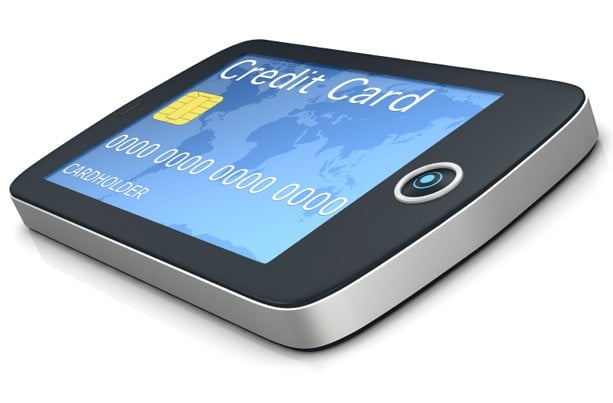The New Way to Pay – Prepare Your Institution for the Digital Wallet Boom!

By Jason O’Brien, SWBC
Imagine: You’re at a store and ready to pay when you realize that you’ve forgotten your wallet. Embarrassed and frustrated, you tell the cashier to cancel your transaction and that you’ll come back later. At this point, the cashier says, “No problem. If you have a smartphone, we can finish your payment right now.”
How cool would that be?
Recently, retail heavyweights such as Wal-Mart Stores, Inc., Target Corp., Best Buy Co., and CVS/pharmacy have banded together to create the Merchant Customer Exchange (MCX) with the purpose of offering consumers a mobile commerce solution that may soon be the universal way to pay for goods. Additionally, major names such as Google®, Apple®, AT&T®, Sprint®, and PayPal® have made significant investments in mobile wallet platforms in the past few years. Now that major retail locations have a solution around the corner, we may be nearing a major increase in the adoption of mobile wallets. According to a press release from Gartner Research:
- In 2012, the number of mobile payment users was 212.2 million, an increase from 160.5 million in 2011.
- By 2015, mobile payments will account for $617 billion in gross dollar volume.
Digital wallets – when they come into full force – have the potential to affect a broad range of stakeholders, including mobile network operators, handset manufacturers, operating system providers, retailers, consumers, and of course financial institutions. That’s why we’re sharing with you the emerging landscape of digital wallets, the opportunities it will present to you, and the threats it may create.
HOW MOBILE WALLETS WORK
A digital wallet typically organizes payment cards, special offers, and loyalty cards in one convenient application on a consumer’s smart device, and retailers support these wallets through payment terminals that supplement their point-of-sale systems. Below are two popular methods:
- Near Field Communication (NFC): NFC is a special chip that mobile manufactures are installing in select smart devices. They are designed to interact with NFC scanners at retail locations, allowing consumers to make a payment by scanning their smartphone or tablet. The number of retail locations with NFC scanners is growing, and it’s the technology Google, AT&T, Sprint, Visa®, and MasterCard® are adopting. There are a growing number of mobile devices, primarily phones based on Google’s Android™ platform, with NFC, but the technology is not yet a predominant feature.
- Non-NFC: Non-NFC-based payments are currently made through either a special payment terminal, which is utilized by PayPal at select retailers, that prompts the consumer to type in user credentials (i.e., their mobile phone number and a PIN) to authorize the transfer of funds or through a special optical scanner that reads bar codes presented in an application on the user’s smart device. This platform appears to be limited to gift card and coupon redemption, but there is discussion that Apple may turn bar code scanning applications into a full-form payment mechanism.
SECURITY
As with many items involving personal identity and card information, there is tremendous concern over security. The major players in this arena take security very seriously and are designing technologies to ensure information at rest (stored on servers/mobile devices) is limited, communications are encrypted, and users have tools to manage the security of their mobile wallets. For example, to freeze activity on a mobile wallet, the consumer can simply go online to prohibit transactions on any of the accounts stored in the mobile wallet. This means accounts can be frozen in a fraction of the time it would take to search for a lost wallet and freeze each account manually.
Recommendations to consumers for keeping mobile wallets secure include enabling screen locks on smart devices, not utilizing unsecured or untrusted wireless networks, strictly managing necessary usernames and passwords, and keeping applications and operating systems on smart devices updated. As with any form of payment, mobile wallet users must take responsibility of securing their smartphone and/or tablet at all times because if left out in the open and unsecured, the chance remains that somebody could take your money.
OPPORTUNITIES
Before the masses start using mobile wallets, and that form of payment becomes mainstream, your institution should start thinking about how to position itself for success. Consumers are always looking for a more convenient way to pay, and most of the current solutions support multiple card types and are not limited to proprietary funding channels. And, they are backed by traditional credit/debit cards or prepaid debit cards – which your institution probably offers. To stay competitive, you should position your cards as a conduit for this new convenient technology. By not clearly identifying that your cards can power many of the popular mobile wallet offerings, you run the risk of consumers moving funds to accounts that tout such capabilities.
Additionally, if you provide merchant account services for commercial accounts, be sure to let them know how they can leverage smart devices for payment acceptance. Generally, merchant service providers are geared to support you with this type of information. SWBC’s own merchant card program offers mobile merchant support.
THREATS
Two major threats to financial institutions are looming with mobile wallets. First, the predominant mobile commerce solution has not been determined, as mobile wallets have not been widely adopted yet. This creates ambiguity about which platform(s), if any, should receive an investment. Keep yourself up-to-date and keep an eye on these emerging mobile payment solutions, as your organization will need to determine which opportunities are most lucrative.
Second, consumers are being targeted by non-traditional financial providers to use their mobile payment services. For example, they offer reloadable debit cards and encourage consumers to keep their cash on these cards. This is a direct threat to checking accounts offered by your financial institution, as consumers may elect to keep their money elsewhere to obtain the perceived value of these non-traditional providers’ offerings. That’s why it’s imperative, should you choose to enter this arena, to promote your mobile capabilities and remind your accountholders of the value of FDIC coverage, the numerous benefits offered with your accounts, and the flexibility your accounts offer to thwart this threat.
CONCLUSION
There is significant push by retailers, software companies, and telecommunication giants to get a predominant digital wallet in the hands of consumers in the hopes of being part of their daily spending activity. We appear to be on the brink of a major transition, which is why it’s important that you stay abreast of changes in our ever-changing marketplace and understand how to take advantage of this exciting opportunity.
For more information about mobile merchant support offered by SWBC, call 866-316-1162 today!





